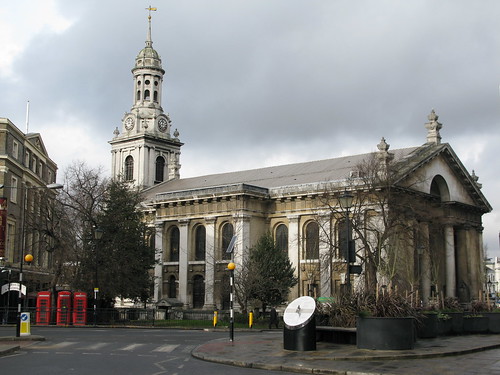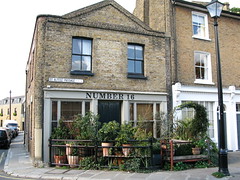Time is central to Greenwich’s modern identity yet things weren’t always so fixed around the meridian. The earliest settlers of the area ran on another calendar and their New Year (Samhain) fell on the 31st of October. They had different beliefs and relationships to the dead and there are traces of pagan worship and even witchcraft all over Greenwich. The park with its Observatory should stand as a monument to science (the first astronomer John Flamsteed wrote a horoscope for the Observatory because he despised astrologers) but is actually laden with old lore, and of course the Bronze Age Tumuli later used as a Saxon burial ground.
HV Morton -writing in the mid twentieth century- reported Japanese folk worshiping the cedar trees whilst some claim the Roman ruins are a temple to the goddess of the hunt, Diana. This ties in rather nicely with the notion that there is a sacred well to Anglo Saxon goddess Holda. Better known as the Snow Well all that remains of this is an indentation. Holda was goddess of many things from spinning to reproduction and women standing in the depression of the well have reported “strange but not unpleasant sensations”. Local folklorist Jack Gale links the well, via King William Walk, to the site where the May poles once stood, pagan relics that lasted well into the Christian era.
Even today one of the most iconic (albeit temporarily covered) landmarks, the Cutty Sark, has a witch (Nannie) clutching a horse’s tail for a figurehead and spectral man has been spotted keeping watch from the crows nest. Also the whole of the World Heritage Centre area owes its existence to an accusation of witchcraft. Before the current buildings were built there was that favourite Tudor residence the Palace of Placenta which was once known as Bella Court and belonged to Duke Humphrey of Gloucester. It was a very lovely spot. So lovely that Margeurite of Anjou, the rather pushy wife of Henry VI, fancied it for her own. To this end she accused Humphrey’s wife of dabbling in the dark arts, specifically attacking a likeness of the king with pins. During the resultant arrests Humphrey died in custody whilst helping the archbishops with their enquiries and the property passed to Henry (and his wife).

St Alfege Church – built on the site where St Alfege was beaten to death with animal bones.
Then again the archbishops could just have thought they were getting revenge on the pagan murderers of their predecessor St Alfege, beaten to death with animal bones by Danes on the site where his church now stands. In fact if violent death and revenge hauntings are truly the reason most spectres are with us then Greenwich should be awash with bitter and vengeful spirits.

As it is there are plenty of phantoms, just not of the wrathful kind. Instead many of them are slightly sad, and easily got rid of if the one that formerly haunted 16 St. Alfege Passage is anything to go by. This phantom (of a young Edwardian chap with long hair) manifested in traditional ways such as moving objects, walking the stairs late and leaving certain visitors with a choking sensation. These sensations were strongest near a beam and the former vicar of St. Alfege (brandishing bells, salt, water and incense) who laid the spirit suggested that it might have been the trapped soul of a suicide who had hung himself.
Another sad tale occurs up on Croom’s Hill at St Mary’s Lodge when one day Tom Potter come knocking. He was looking for his mother who once worked as a maid there. The replacement parlour cleaning executive expressed no knowledge of Tom’s mother but the lady of the house, who overheard the exchange, remembered her former servant and sent word to her new address that her son was looking for her. She received the rather shocking reply that Tom was unlikely to have been knocking on doors in Greenwich on that particular date as that was when he had died many miles away in Jamaica. Tom’s funeral obviously never occurred in Greenwich but, as if to make up, elsewhere on Crooms Hill, near the gate, has been seen a group of red haired women carrying a coffin towards the park. If this isn’t disturbing enough their legs ended at the kneecaps.
This reporting of legs disappearing into the ground is a staple of ghost lore and is usually explained as the ghosts walking on the street or floor level that existed when they were alive. As London has risen street on street century on century burying people, buildings and much else so today’s “floor” may be several feet higher than when the spirits of the departed walked once when alive. In death it would appear that they are trapped on their own level. Sadly no such restrictions apply to the other being spotted near the gate, a repulsive, dwarf like figure that just loiters about.
It’s possible that he lives underground in one the numerous tunnels that supposedly catacomb Greenwich. Some of these, the old Blackheath Caverns, former chalk mines under Point Hill for example, are well documented whilst others belong to an era of highwaymen, smugglers and rebellion. Given the associations of nearby Shooters Hill with highwaymen one might have expected their ghosts on the hill and not a murdered blonde from the 1830s on the hill or at Veremont House a wicked lady with striking dark eyes and hair who, spurned in love, murdered her second cousin. There is however the chilling sight of Lord John Angerstein’s coach on the Vanbrugh Hill being pulled by four headless horses along the Trafalgar Road.
The Trafalgar pub is supposedly visited by a Victorian gentleman who likes to stroll the higher floors mostly but is not above sifting things from the cellar. However it is time to bury the tale (or should that be tail?) of the black dog of the Spanish Galleon. The story that the pub is haunted by Shuk the hell hound of folklore (or grim to Harry Potter fans) arises from the night when things got out of hand at the South East London Folklore Society who formerly met there. The speaker and others decided to see whether is was possible to conjure up Shuk but no dog actually appeared.
Some spirits seem only too keen to pop up though and the two most reported apparitions of Greenwich are the phantom of the Tulip Staircase in the Queen’s House and the shade of Admiral Byng (who was executed for treason) wandering the Queen Anne Court, and elsewhere. The Court, was where he was fixed to wall prior to his execution, yet despite this treatment he is by all accounts a cheery and helpful spirit and also one that, according to the earliest reports shortly after his death, favoured the famous with his attentions. A lesser spotted spectre haunts the site of a more modern attraction (the Millennium Dome) which is home to the shade of Sir George Livesey who (as former chairman of gas works which stood on the Peninsular) popped up to view the new building.
It is perhaps fitting that as time moves forward and the clock trips towards All Souls Eve that we should remember these previous residents of the village by the green who have apparently never gone away. Some of these stories are classics, like the ghostly hitchhiker at the Greenwich end of the Blackwell Tunnel, but it is worth asking if there is nothing to the tales why do people keep telling them?
Chris Roberts is editor of the 21st century penny dreadful One Eye Grey which features modern stories based on traditional London folklore and tales of the uncanny, paranormal and supernatural.
Sources for the article include local folklorists Jack Gale and Jacqueline Woodward-Smith as well as the South East London Folklore Society reference library, the Greenwich Phantom and the ever reliable paranormal database (www.paranormaldatabase.com).
PS Those interested in a cinematic horror tour of the area should go to Greenwich Council film location site where amongst the films are The mummy returns, 28 days later, 28 weeks later and Beyond the rave. Nearby Deptford was used in Quatermass and the pit and more amusingly mocked up as New Orleans for Interview with a vampire.
Got any experiences of ghosts in Greenwich? Add your comments below…
